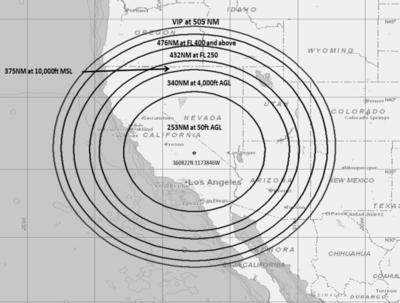Thu, Jun 09, 2016
Signals May Be Intermittently Unreliable Or Unavailable During The Month Of June
The FAA is conducting a series of GPS interference tests on the west coast of the U.S. during the month of June.

The testing began Tuesday centered at 360822N/1173846W or the BTY VOR 214 degree radial at 059 NM. The agency issued a NOTAM indicating that GPS signals may be unreliable or unavailable during the testing periods.
Additional tests are scheduled as follows:
- 9 JUN 16 1630Z – 2230Z
- 21 JUN 16 1630Z – 2230Z
- 23 JUN 16 1630Z – 2230Z
- 28 JUN 16 1630Z – 2230Z
- 30 JUN 16 1630Z – 2230Z
The altitude at which the reliability of GPS signals may be effected decreases depending on an aircraft's proximity to the testing site. According to the FAA, signals are affected as follows:
- 432NM RADIUS AT FL250
- 375NM RADIUS AT 10000FT
- 340NM RADIUS AT 4000FT AGL
- 253NM RADIUS AT 50FT AGL
The FAA singled out operators of Embraer Phenom 300 jets to pay particular attention to the NOTAM. According to the FAA, Embraer has recently received a report of GPS 1 and 2 simultaneous signal loss during fms navigation in cruise flight followed by a GPS HSI 1 and 2 failure indication, attitude and heading reference system (AHRS) 1 and 2 fault and, after a few minutes, a stall warning protection system (SWPS) fault, ventral rudder fail, yaw damper fail, auto pilot fail, and cas messages associated with unexpected rolling and yawing oscillations (dutch roll) at high airspeeds.
Further analysis revealed GPS constellation signal instability in the flight area leading to loss of both gps information data and causing the event described above. The AHRS continuously calculates and applies altitude and heading measurement updates to correct gyro-integrated altitude and heading during flight maneuvers and, in normal operation, the ahrs relies upon GPS, air data system and magnetic field measurements supplied by the magnetometer to maintain primary ahrs operation mode.
The dutch roll behavior may be expected for an airplane with no yaw damper and/or ventral rudder protection, especially on aircraft with swept wings. If this anomaly occurs controllers can expect the pilot may reduce speed below 240 kias and initiate an emergency descent.
All operational personnel must be briefed on this notice as soon as possible.
The FAA recommends that operators of Phenom jets avoid the test area during times that tests are being conducted.
(FAA image)
More News
Aero Linx: International Federation of Airworthiness (IFA) We aim to be the most internationally respected independent authority on the subject of Airworthiness. IFA uniquely combi>[...]
Ultrahigh Frequency (UHF) The frequency band between 300 and 3,000 MHz. The bank of radio frequencies used for military air/ground voice communications. In some instances this may >[...]
A Few Questions AND Answers To Help You Get MORE Out of ANN! 1) I forgot my password. How do I find it? 1) Easy... click here and give us your e-mail address--we'll send it to you >[...]
From 2019 (YouTube Edition): Learning To Paint Without Getting Any On Your Hands PPG's Aerospace Coatings Academy is a tool designed to teach everything one needs to know about all>[...]
Also: Sustainable Aircraft Test Put Aside, More Falcon 9 Ops, Wyoming ANG Rescue, Oreo Cookie Into Orbit Joby Aviation has reason to celebrate, recently completing its first full t>[...]
 ANN's Daily Aero-Linx (05.06.25)
ANN's Daily Aero-Linx (05.06.25) ANN's Daily Aero-Term (05.06.25): Ultrahigh Frequency (UHF)
ANN's Daily Aero-Term (05.06.25): Ultrahigh Frequency (UHF) ANN FAQ: Q&A 101
ANN FAQ: Q&A 101 Classic Aero-TV: Virtual Reality Painting--PPG Leverages Technology for Training
Classic Aero-TV: Virtual Reality Painting--PPG Leverages Technology for Training Airborne 05.02.25: Joby Crewed Milestone, Diamond Club, Canadian Pilot Insurance
Airborne 05.02.25: Joby Crewed Milestone, Diamond Club, Canadian Pilot Insurance



